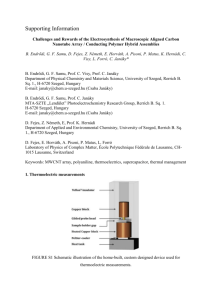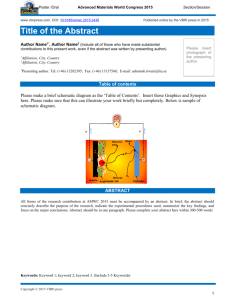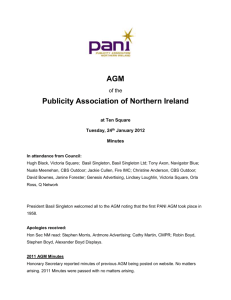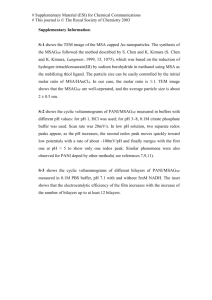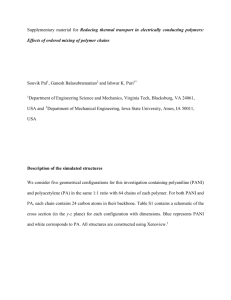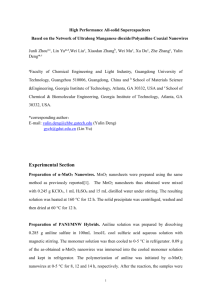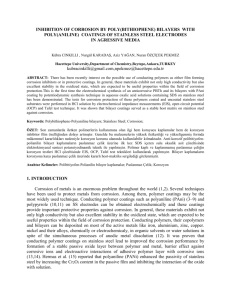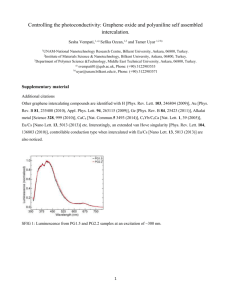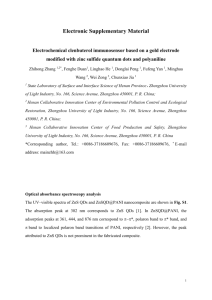PBTh/PAni
advertisement
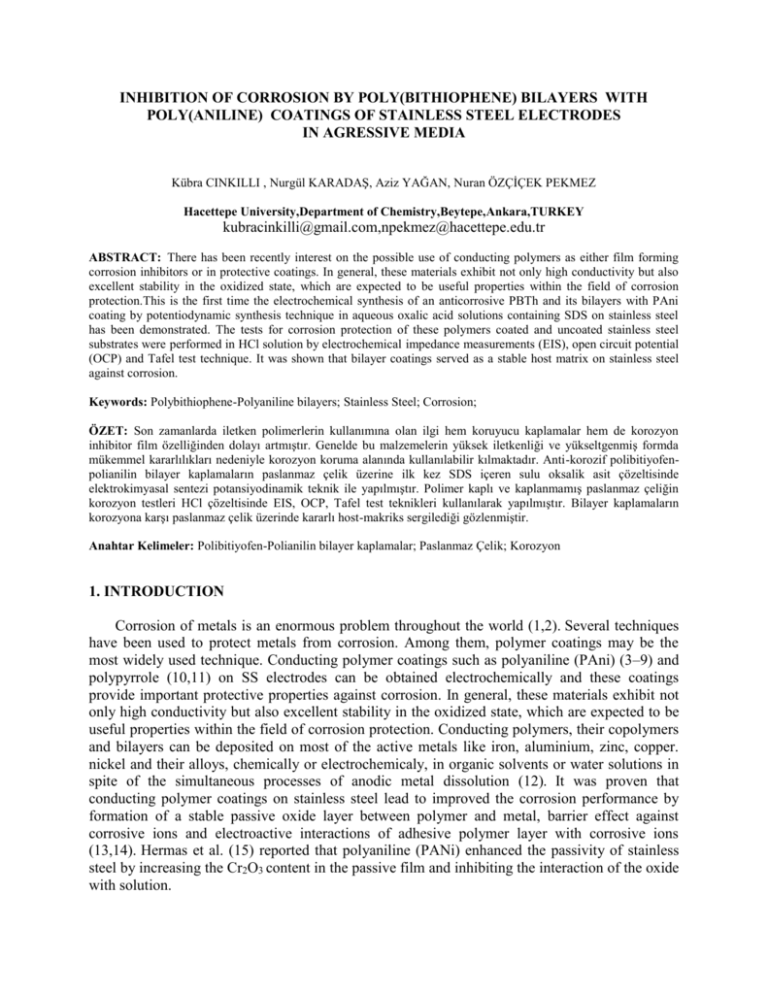
INHIBITION OF CORROSION BY POLY(BITHIOPHENE) BILAYERS WITH POLY(ANILINE) COATINGS OF STAINLESS STEEL ELECTRODES IN AGRESSIVE MEDIA Kübra CINKILLI , Nurgül KARADAŞ, Aziz YAĞAN, Nuran ÖZÇİÇEK PEKMEZ Hacettepe University,Department of Chemistry,Beytepe,Ankara,TURKEY kubracinkilli@gmail.com,npekmez@hacettepe.edu.tr ABSTRACT: There has been recently interest on the possible use of conducting polymers as either film forming corrosion inhibitors or in protective coatings. In general, these materials exhibit not only high conductivity but also excellent stability in the oxidized state, which are expected to be useful properties within the field of corrosion protection.This is the first time the electrochemical synthesis of an anticorrosive PBTh and its bilayers with PAni coating by potentiodynamic synthesis technique in aqueous oxalic acid solutions containing SDS on stainless steel has been demonstrated. The tests for corrosion protection of these polymers coated and uncoated stainless steel substrates were performed in HCl solution by electrochemical impedance measurements (EIS), open circuit potential (OCP) and Tafel test technique. It was shown that bilayer coatings served as a stable host matrix on stainless steel against corrosion. Keywords: Polybithiophene-Polyaniline bilayers; Stainless Steel; Corrosion; ÖZET: Son zamanlarda iletken polimerlerin kullanımına olan ilgi hem koruyucu kaplamalar hem de korozyon inhibitor film özelliğinden dolayı artmıştır. Genelde bu malzemelerin yüksek iletkenliği ve yükseltgenmiş formda mükemmel kararlılıkları nedeniyle korozyon koruma alanında kullanılabilir kılmaktadır. Anti-korozif polibitiyofenpolianilin bilayer kaplamaların paslanmaz çelik üzerine ilk kez SDS içeren sulu oksalik asit çözeltisinde elektrokimyasal sentezi potansiyodinamik teknik ile yapılmıştır. Polimer kaplı ve kaplanmamış paslanmaz çeliğin korozyon testleri HCl çözeltisinde EIS, OCP, Tafel test teknikleri kullanılarak yapılmıştır. Bilayer kaplamaların korozyona karşı paslanmaz çelik üzerinde kararlı host-makriks sergilediği gözlenmiştir. Anahtar Kelimeler: Polibitiyofen-Polianilin bilayer kaplamalar; Paslanmaz Çelik; Korozyon 1. INTRODUCTION Corrosion of metals is an enormous problem throughout the world (1,2). Several techniques have been used to protect metals from corrosion. Among them, polymer coatings may be the most widely used technique. Conducting polymer coatings such as polyaniline (PAni) (3–9) and polypyrrole (10,11) on SS electrodes can be obtained electrochemically and these coatings provide important protective properties against corrosion. In general, these materials exhibit not only high conductivity but also excellent stability in the oxidized state, which are expected to be useful properties within the field of corrosion protection. Conducting polymers, their copolymers and bilayers can be deposited on most of the active metals like iron, aluminium, zinc, copper. nickel and their alloys, chemically or electrochemicaly, in organic solvents or water solutions in spite of the simultaneous processes of anodic metal dissolution (12). It was proven that conducting polymer coatings on stainless steel lead to improved the corrosion performance by formation of a stable passive oxide layer between polymer and metal, barrier effect against corrosive ions and electroactive interactions of adhesive polymer layer with corrosive ions (13,14). Hermas et al. (15) reported that polyaniline (PANi) enhanced the passivity of stainless steel by increasing the Cr2O3 content in the passive film and inhibiting the interaction of the oxide with solution. In 1985 DeBerry reported that PANI coating on passivated steel in a strong acidic solution enhanced the corrosion protection of SS (16). Substituted polythiophene (PTh) coating was first shown to offer corrosion resistance property by Deng and coworkers (17) In 1992, Ren and Barkey showed that electrochemically synthesized PTh film could provide important protection to stainless steel, under acidic conditions (18). Most of these studies were carried out in nonaqueous solution, because such monomers present a serious drawback regarding their solubility, particularly in water. Many efforts have been made with a view to improving this property (19–21). Lagrost et al. showed that electropolymerization of bithiophene and thiophene derivatives on Pt and a glassy carbon electrode could be performed in water in the presence of either sodium dodecyl sulfate (SDS) or hydroxypropyl-β-cyclodextrin under potentiostatic conditions (22). In this study, PBTh bilayers with PAni on SS in aqueous oxalic acid solution containing bithiophene and aniline monomers in the presence of SDS was synthesized under potentiostatic conditions. Corrosion protection effect of PBTh/ PAni and PAni/ PBTh bilayers for stainless steel electrodes was investigated by comparing with that for uncoated stainless steel by using Tafel test, open circuit potential (OCP) and EIS in 0.5 M HCl solutions. 2. EXPERIMENTAL Aniline (Riedel-de Haen) monomer was distilled under vacuum before use. Bithiophene monomer supplied from Fluka was used directly. Oxalic acid and sodium dodecyl sulfate (SDS) were received from Merck and Sigma-Aldrich, respectively. In all electrosynthesis experiments, an aqueous solution containing the monomer, SDS and oxalic acid was prepared by using doubly distilled water. Electrochemical measurements were carried out in a single compartment threeelectrode cell with SS disc as working electrode, platinum foil as counter electrode and saturated calomel electrode (SCE) as reference electrode. The 304- stainless steel disc electrode (0.07 cm2) and rod electrode (0.539 cm2) used for electrosynthesis. Before each experiment, the working electrode was polished with a series of wet sanding of different grit sizes (320 -1200). After polishing, SS electrode was washed with doubly distilled water and dried at room temperature. The coatings prepared electrochemically were immersed in distilled water to remove adsorbed electrolyte, monomer and the soluble oligomers formed during electropreparation of the coating and then dried for 1 h at room temperature before investigating the corrosion protection effect. All electrochemical studies were carried out with CHI 660B electrochemical analyzer under computer control. Anti-corrosion control of the coated electrodes was carried out by Tafel, open circuit potential(Eocp)-time and EIS measurements in 0.5 M HCl solution. Tafel tests were carried out by polarizing from cathodic to anodic potentials with respect to open circuit potential at a scan rate of 1 mV/s. Electrochemical impedance measurements were carried out in the frequency range of 105 to 10−2 Hz with amplitude of 7 mV at the corrosion potential of bilayer coatings and uncoated electrodes. 3.RESULTS AND DISCUSSION 3.1. Electrosynthesis of bilayer coatings In order to improve the conductivity properties of protective PBTh coating, the electrosynthesis of its bilayer with PAni, which has higher conductivity value, was considered. To synthesize PBTh/ PAni and PAni/ PBTh bilayers, the first layers have been electropolymerized under their own electrosynthesis conditions obtained above. Second layers were obtained with a scan rate 20 mV s-1 by examining the scanning potential limits during the electrosynthesis in polymerization solution containing the other monomer. Electrosynthesis of PBTh/PAni bilayer was carried out in aqueous 0.1 M SDS solution containing 0.05 M bithiophene, 0.1 M oxalic acid and then containing 0.075 M aniline, 0.2 M oxalic acid and 0.1 M SDS. On the other hand, PAni/PBTh bilayer was obtained by inverting the process. When the effect of the scanning potential limits during the electropolymerization of second layer for PBTh/PAni was investigated, the smallest current density value was obtained with the film under potential sweeps between -0.2 and 1.1 V vs. SCE according to the potentiodynamic polarization curves taken in 0.5 M NaCl corrosive medium 3.2.Corrosion Behaviour of Bilayer and Its Homopolymer Coatings Tafel tests: The corrosion performance of bilayer coatings and uncoated SS electrodes were studied by polarizing from cathodic to anodic potentials with respect to open circuit potential at a scan rate of 1 mV/s by using Luggin capillary in 0.5 M HCl solution. Figure 1 shows the polarization curves for PBTh, PAni, PBTh/PAni, PAni/PBTh coated and uncoated electrodes. After about −0.34 V, while the potential increases, the current of uncoated SS decreases, which is related to the formation of a passive film on the SS surface. The uncoated electrode starts to dissolve with Figure 1. Tafel curves of uncoated, PAni, PBTh, PBTh/PAni and PAni/PBTh bilayers coated SS electrodes in 0.5 M HCl solution (v = 1 mV s-1) breakdown of passive film after about −0.15V and the current density increases. Current density of cathodic and anodic Tafel lines of homopolymer and bilayer coated SS electrodes decrease significantly compared to that of uncoated steel, in spite of the contribution originating from the electroactivity of protective conducting polymer coating (23). As can be seen in Figure 1, the corrosion potentials of PBTh, PAni/PBTh, PAni and PBTh/PAni coatings SS electrodes shift in the positive direction compared to that of the uncoated electrode. The dissolution potential of coated electrodes at anodic polarization also shifted toward positive direction. Table 1 summarizes that the corrosion current densities (Icorr) and corrosion potentials (Ecorr) are determined by extrapolation of the linear portions of the anodic and cathodic Tafel curves in Figure 1. Analysis of these data shows that Icorr values of coated electrodes decrease significantly when compared with that of uncoated electrode. The homopolymer and bilayer coatings restrict the anodic and cathodic reactions of stainless steel in aggressive media. Table 1: Corrosion potential (Ecorr) and corrosion currents (Icorr) obtained from polarization curves (Figure 1) in 0.5 M HCl medium for PBTh and PAni homopolymers and their bilayers coated surfaces under their own optimum conditions. PBTh PAni PBTh/PAni PAni/PBTh Stainless steel Ecorr / V -0.34 -0.053 -0.058 0.23 -0.37 Icorr / mA cm-1 3.40 x 10-3 2.27 x 10-3 6.01 x 10-3 8.92 x 10-3 0.121 Open Circuit Potential: The Eocp values measured in 0.5 M HCl solution for uncoated and PBTh, PAni, PBTh/PAni and PAni/PBTh coated SS electrodes after various immersion times were ploted against time and are given in Figure 2 and Table 2. Initial Eocp value of uncoated electrode was −0.432 V and Figure 2. Eocp – time curves of uncoated, PAni, PBTh, PBTh/PAni and PAni/PBTh bilayers coated SS electrodes in 0.5 M HCl solution Electrochemical impedance spectroscopy: Impedance measurements provide information on both the resistive and capacitive behavior of the interface and makes possible to evaluate the performance of polymer coatings as a protective layer against metal corrosion (24). Figure 3,4,5,6,7 shows the Nyquist plots and corresponding Bode plots of uncoated SS and PBTh, PAni, PBTh/PAni, PAni/PBTh coating SS electrodes recorded after various exposure time in 0.5 M HCl, respectively. As can be seen Figure 3a the impedance diagram uncoated SS is in the shape of a depressed semicircle and Rct value is equal to the diameter of the semicircle, which is 285.9 ohm. Uncoated steel exhibited a low polarization resistance due to the easy attack of the corrosive chloride ions on steel surfaces (25). Rct values which is refer to charge transfer resistance of the steel/electrolyte interface and the conducting polymer coatings resistance for PBTh, PAni, PBTh/PAni, PAni/PBTh coating SS in HCl solution are significantly higher than those of the uncoated steel due to inhibition of electron transfer to polymer from metal (Figure 4,5,6,7 and Table 3,4). This indicates that the protection mechanism involves the formation of a high-resistance oxide film induced by electroactive polymer coating. Consequently, the insertion and the transport rate of anions to interface of Polymer/SS system in aqueous acidic chloride solution are difficult. The electroactive and conducting PBTh, PAni, PBTh/PAni, PAni/PBTh coatings exhibit effectively protective properties and performance HCl solution. Figure 3.a. Impedance spectra b. Bode plots of stainless steel electrodes in 0.5 M HCl after 15 minutes immersion time The inhibition efficiency was evaluated from the measured charge transfer resistance Rct values as Rct1 is the so-called high-frequency ionic charge transfer resistance at the polymer– electrolyte interface or electron transfer resistance at the SS/polymer interface. Rct2 is the lowfrequency electron transfer resistance of the redox reactions. The slightly suppressed nature of the semicircle may indicate that the interfacial impedance results from more than one electrochemical process possible related to the polymeric film and to the changes of the double layer (24). CPE is employed to instead of the double layer capacitance (Cdl) reflected an ideal capacitor to describe the non-homogeneities in the system. Rct and CPE jointly belong to the electrochemistry of corrosion at the polymer-metal interphase after coating penetration by corrosive anions. The CPE comprises the capacitance of both double layer and the conductive film. CPE = [Q(wj) a] –1. Q is the frequency independent constant, and w is the angular frequency, a values are the correlation coefficients for the CPE (0 < a < 1). The corrosion kinetic parameters obtained uncoated and polymer coated stainless steel in 0.5 M HCl solution are given in Table 3 & 4. (a) (b) Figure 4 a. Impedance spectra b. Bode plots of PAni coated stainless steel electrodes in 0.5 M HCl at different immersion time Although PBTh coating was effective barrier coating for SS in short period time (15 min), PBTh/PAni bilayer exhibited better protection than PBTh in long period time in HCl medium. (a) (b) Figure 5.a. Impedance spectra b. Bode plots of PBTh coated stainless steel electrodes in 0.5 M HCl at different immersion time. (a) (b) Figure 6.a. Impedance spectra b. Bode plots of PAni/ PBTh coated stainless steel electrodes in 0.5 M HCl at different immersion time (a) (b) Figure 7.a. Impedance spectra b. Bode plots of PBTh/ PAni coated stainless steel electrodes in 0.5M HCl at different immersion time Table 3. The Rs , Rct , CPEand σ values for Pani, PBTh coated electrodes after various immersion times in 0.5 M HCl t(h) Rs / ohm Rct / ohm uncoated 15 min 2.692 2.859x102 CPE /µF cm-2 σ / Ω.cm-2.s-1/2 34.74 PAni 15 min 2h 4h 48 h 120 h 2.861 9.668 4.063 4.216 4.170 2.410 x102 1.214 x103 7.261 x102 4.384 x102 3.785 x102 77.23 66.36 26.59 306.6 418.8 0.013 ---------- PBTh 15 min 2h 6h 24 h 72 h 120 h 50.44 52.99 30.04 8.916 6.773 5.944 7.812 x104 8.534 x103 2.796 x103 1.410 x103 6.991 x102 6.492 x102 20.20 93.48 159.9 187.7 596.6 727.5 ------------------- Table 3. The Rs , Rct , CPE values for uncoated and PAni/PBTh , PBTh/Pani coated electrodes after various immersion times in 0.5 M HCl t(h) Rs 1 / ohm Rct 1 / ohm PAni/PBTh 15 min 23.20 2h 24.57 24 h 13.50 48 h 5.898 PBTh/PAni 15 min 35.68 2h 44.39 6h 54.16 24 h 35.69 72 h 6.393 96 h 6.172 1.708 x103 2.322 x102 6.026 x102 4.410x102 1.745 x103 2.491 x103 2.202 x103 7.090 x102 8.090 x102 6.627 x102 Rs 2 / ohm Rct 2 / ohm CPE1 /µF cm-2 CPE 2/µF cm-2 ---129.2 ------5.461 x102 1.694 x103 1.341 x103 4.304 x102 ------- ---6.216 x102 ------1.840 x104 1.108 x104 3.794 x103 2.373 x103 ------- 337.6 1.126 x103 350.1 137.9 2.597 1.042 8.163 62.54 96.03 170.2 718.5 ------- 65.53 82.87 209.3 238.6 ------- 4.CONCLUSIONS The electroactive PBTh, PAni, PBTh/PAni, PAni/PBTh have been electrodeposited on 304 stainless steel electrode from aqueous oxalic acid solution with SDS by using potentiodynamic synthesis technique The corrosion behavior of these coating polymers under immersion in highly aggressive HCl solution was studied by Tafel Test, Open Circuit Potential and EIS techniques. The results show that PBTh, PAni, PBTh/PAni, PAni/PBTh coating on SS as conducting polymer coatings exhibited effective protective behavior in highly corrosive media containing acidic chloride anions and decreased the corrosion rate of stainless steel but PBTh/PAni bilayer exhibit better protection than the other coatings in long period time in HCl medium. 5.REFERENCES 1. B. Scrosati, Prog. Solid State Chem. 18, 1, 1988. 2. T. Osaka, S. Ogano, K. Naoi, N. Oyama, J. Electrochem. Soc. 136, 306, 1989. 3. R. Santos Jr., L.H.C. Mattoso, A.J. Motheo, Electrochim. Acta 43, 309, 1998. 4. D.W. DeBerry, Electrochem. Soc. 132, 1022, 1985. 5. B. Wessling, Adv. Mater. 6, 226, 1994. 6. P.A. Kilmartin, L. Trier, G.A. Wright, Synth. Met. 131, 99, 2002. 7. S.R. Moraes, D. Huerta-Vilca, A.J. Motheo, Prog. Org. Coat. 48, 28, 2003. 8. A.A. Hermas, M. Nakayama, K. Ogura, Electrochim. Acta 50, 2001, 2005. 9. D. Sazou, M.Kourouzidou, E. Pavlidou, Electrochim. Acta 52, 4385, 2007. 10. P. Herrasti, P. Ocon, Appl. Surf. Sci. 172, 276, 2001. 11. M.A. Malik, R. Włodarczyk, P.J. Kulesza, H. Bala, K. Miecznikowski, Corros. Sci. 47, 771, 2005. 12. A. Kupniewska and S. Bialiozor, J Advances in Engineering Science Sect. A 1, 33, 2007. 13. M.C. Bernard, C. Deslouis, T. El Moustafid, A.H. Goff, S. Joiret, B. Tribollet, Synth. Met. 102, 1381, 1999. 14. M. Kraljic, Z. Mandic, L. Duic, Corr. Sci. 45, 181, 2003. 15. A.A. Hermas, M. Nakayama, K. Ogura, Electrochim. Acta 50, 2001, 2005. 16. D.W. DeBerry, J. Electrochem. Soc. 132, 1022, 1985. 17. Z. Deng, W.H. Smyrl, H.W. White, J. Electrochem. Soc. 136 (8), 2152, 1989. 18. S. Ren, D. Barkey, J. Electrochem. Soc. 139, 1021, 1992. 19. S. Holdcroft, J. Polym. Sci. B: Polym. Phys. 29, 1585, 1981. 20. M. Sato, H. Mori, Macromolecules 24, 1196, 1991. 21. H.S. Nalwa, Polymer 32, 745, 1991. 22. C. Lagrost, M. Jouini, J. Tanguy, S. Aeiyach, J.C. Lacroix, K.I. Chane-Ching, P.C. Lacaze, Electrochimica Acta 46, 3985, 2001 23. L. Zhong, H. Zhu, J. Hu, S. Xiao, F. Gan, Electrochim. Acta 51, 5494, 2006. 24. S.L.A. Maranhao, I.C. Guedes, F.J. Anaissi, H.E. Toma, I.V. Aoki, Electrochim. Acta 52, 519, 2006 25. N.V. Krstajic, B.N. Grgur, S.M. Jovanovic, V. Vojnovic, Electrochim. Acta 42, 1685,1997
